Zhiyuan Ning
Distilling Closed-Source LLM's Knowledge for Locally Stable and Economic Biomedical Entity Linking
May 26, 2025Abstract:Biomedical entity linking aims to map nonstandard entities to standard entities in a knowledge base. Traditional supervised methods perform well but require extensive annotated data to transfer, limiting their usage in low-resource scenarios. Large language models (LLMs), especially closed-source LLMs, can address these but risk stability issues and high economic costs: using these models is restricted by commercial companies and brings significant economic costs when dealing with large amounts of data. To address this, we propose ``RPDR'', a framework combining closed-source LLMs and open-source LLMs for re-ranking candidates retrieved by a retriever fine-tuned with a small amount of data. By prompting a closed-source LLM to generate training data from unannotated data and fine-tuning an open-source LLM for re-ranking, we effectively distill the knowledge to the open-source LLM that can be deployed locally, thus avoiding the stability issues and the problem of high economic costs. We evaluate RPDR on two datasets, including one real-world dataset and one publicly available dataset involving two languages: Chinese and English. RPDR achieves 0.019 Acc@1 improvement and 0.036 Acc@1 improvement on the Aier dataset and the Ask A Patient dataset when the amount of training data is not enough. The results demonstrate the superiority and generalizability of the proposed framework.
Disentangled Multi-span Evolutionary Network against Temporal Knowledge Graph Reasoning
May 20, 2025Abstract:Temporal Knowledge Graphs (TKGs), as an extension of static Knowledge Graphs (KGs), incorporate the temporal feature to express the transience of knowledge by describing when facts occur. TKG extrapolation aims to infer possible future facts based on known history, which has garnered significant attention in recent years. Some existing methods treat TKG as a sequence of independent subgraphs to model temporal evolution patterns, demonstrating impressive reasoning performance. However, they still have limitations: 1) In modeling subgraph semantic evolution, they usually neglect the internal structural interactions between subgraphs, which are actually crucial for encoding TKGs. 2) They overlook the potential smooth features that do not lead to semantic changes, which should be distinguished from the semantic evolution process. Therefore, we propose a novel Disentangled Multi-span Evolutionary Network (DiMNet) for TKG reasoning. Specifically, we design a multi-span evolution strategy that captures local neighbor features while perceiving historical neighbor semantic information, thus enabling internal interactions between subgraphs during the evolution process. To maximize the capture of semantic change patterns, we design a disentangle component that adaptively separates nodes' active and stable features, used to dynamically control the influence of historical semantics on future evolution. Extensive experiments conducted on four real-world TKG datasets show that DiMNet demonstrates substantial performance in TKG reasoning, and outperforms the state-of-the-art up to 22.7% in MRR.
scSiameseClu: A Siamese Clustering Framework for Interpreting single-cell RNA Sequencing Data
May 19, 2025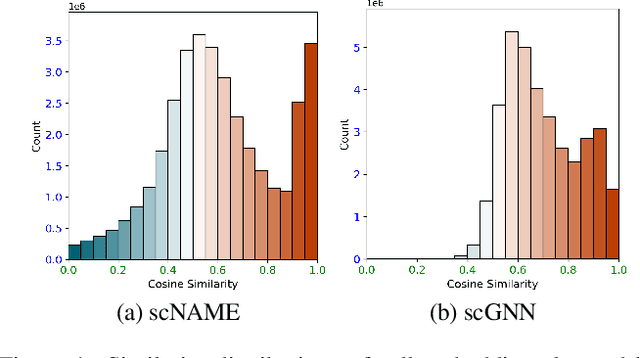
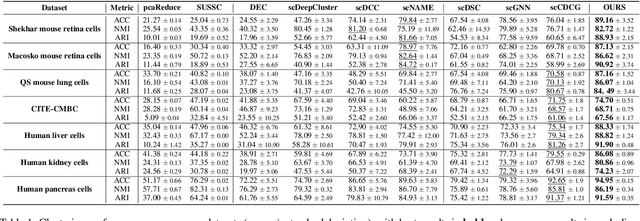
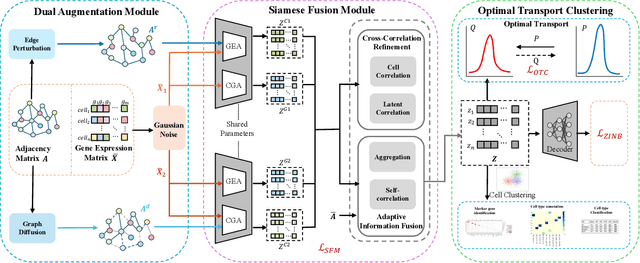

Abstract:Single-cell RNA sequencing (scRNA-seq) reveals cell heterogeneity, with cell clustering playing a key role in identifying cell types and marker genes. Recent advances, especially graph neural networks (GNNs)-based methods, have significantly improved clustering performance. However, the analysis of scRNA-seq data remains challenging due to noise, sparsity, and high dimensionality. Compounding these challenges, GNNs often suffer from over-smoothing, limiting their ability to capture complex biological information. In response, we propose scSiameseClu, a novel Siamese Clustering framework for interpreting single-cell RNA-seq data, comprising of 3 key steps: (1) Dual Augmentation Module, which applies biologically informed perturbations to the gene expression matrix and cell graph relationships to enhance representation robustness; (2) Siamese Fusion Module, which combines cross-correlation refinement and adaptive information fusion to capture complex cellular relationships while mitigating over-smoothing; and (3) Optimal Transport Clustering, which utilizes Sinkhorn distance to efficiently align cluster assignments with predefined proportions while maintaining balance. Comprehensive evaluations on seven real-world datasets demonstrate that~\methodname~outperforms state-of-the-art methods in single-cell clustering, cell type annotation, and cell type classification, providing a powerful tool for scRNA-seq data interpretation.
Rethinking Graph Contrastive Learning through Relative Similarity Preservation
May 08, 2025Abstract:Graph contrastive learning (GCL) has achieved remarkable success by following the computer vision paradigm of preserving absolute similarity between augmented views. However, this approach faces fundamental challenges in graphs due to their discrete, non-Euclidean nature -- view generation often breaks semantic validity and similarity verification becomes unreliable. Through analyzing 11 real-world graphs, we discover a universal pattern transcending the homophily-heterophily dichotomy: label consistency systematically diminishes as structural distance increases, manifesting as smooth decay in homophily graphs and oscillatory decay in heterophily graphs. We establish theoretical guarantees for this pattern through random walk theory, proving label distribution convergence and characterizing the mechanisms behind different decay behaviors. This discovery reveals that graphs naturally encode relative similarity patterns, where structurally closer nodes exhibit collectively stronger semantic relationships. Leveraging this insight, we propose RELGCL, a novel GCL framework with complementary pairwise and listwise implementations that preserve these inherent patterns through collective similarity objectives. Extensive experiments demonstrate that our method consistently outperforms 20 existing approaches across both homophily and heterophily graphs, validating the effectiveness of leveraging natural relative similarity over artificial absolute similarity.
Collaborative Multi-Agent Reinforcement Learning for Automated Feature Transformation with Graph-Driven Path Optimization
Apr 24, 2025Abstract:Feature transformation methods aim to find an optimal mathematical feature-feature crossing process that generates high-value features and improves the performance of downstream machine learning tasks. Existing frameworks, though designed to mitigate manual costs, often treat feature transformations as isolated operations, ignoring dynamic dependencies between transformation steps. To address the limitations, we propose TCTO, a collaborative multi-agent reinforcement learning framework that automates feature engineering through graph-driven path optimization. The framework's core innovation lies in an evolving interaction graph that models features as nodes and transformations as edges. Through graph pruning and backtracking, it dynamically eliminates low-impact edges, reduces redundant operations, and enhances exploration stability. This graph also provides full traceability to empower TCTO to reuse high-utility subgraphs from historical transformations. To demonstrate the efficacy and adaptability of our approach, we conduct comprehensive experiments and case studies, which show superior performance across a range of datasets.
Deep Cut-informed Graph Embedding and Clustering
Mar 09, 2025Abstract:Graph clustering aims to divide the graph into different clusters. The recently emerging deep graph clustering approaches are largely built on graph neural networks (GNN). However, GNN is designed for general graph encoding and there is a common issue of representation collapse in existing GNN-based deep graph clustering algorithms. We attribute two main reasons for such issue: (i) the inductive bias of GNN models: GNNs tend to generate similar representations for proximal nodes. Since graphs often contain a non-negligible amount of inter-cluster links, the bias results in error message passing and leads to biased clustering; (ii) the clustering guided loss function: most traditional approaches strive to make all samples closer to pre-learned cluster centers, which cause a degenerate solution assigning all data points to a single label thus make all samples and less discriminative. To address these challenges, we investigate graph clustering from a graph cut perspective and propose an innovative and non-GNN-based Deep Cut-informed Graph embedding and Clustering framework, namely DCGC. This framework includes two modules: (i) cut-informed graph encoding; (ii) self-supervised graph clustering via optimal transport. For the encoding module, we derive a cut-informed graph embedding objective to fuse graph structure and attributes by minimizing their joint normalized cut. For the clustering module, we utilize the optimal transport theory to obtain the clustering assignments, which can balance the guidance of proximity to the pre-learned cluster center. With the above two tailored designs, DCGC is more suitable for the graph clustering task, which can effectively alleviate the problem of representation collapse and achieve better performance. We conduct extensive experiments to demonstrate that our method is simple but effective compared with benchmarks.
Stealthy Voice Eavesdropping with Acoustic Metamaterials: Unraveling a New Privacy Threat
Jan 25, 2025



Abstract:We present SuperEar, a novel privacy threat based on acoustic metamaterials. Unlike previous research, SuperEar can surreptitiously track and eavesdrop on the phone calls of a moving outdoor target from a safe distance. To design this attack, SuperEar overcomes the challenges faced by traditional acoustic metamaterials, including low low-frequency gain and audio distortion during reconstruction. It successfully magnifies the speech signal by approximately 20 times, allowing the sound to be captured from the earpiece of the target phone. In addition, SuperEar optimizes the trade-off between the number and size of acoustic metamaterials, improving the portability and concealability of the interceptor while ensuring effective interception performance. This makes it highly suitable for outdoor tracking and eavesdropping scenarios. Through extensive experimentation, we have evaluated SuperEar and our results show that it can achieve an eavesdropping accuracy of over 80% within a range of 4.5 meters in the aforementioned scenario, thus validating its great potential in real-world applications.
Towards Graph Prompt Learning: A Survey and Beyond
Aug 26, 2024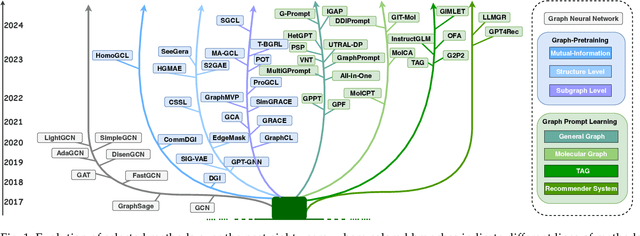

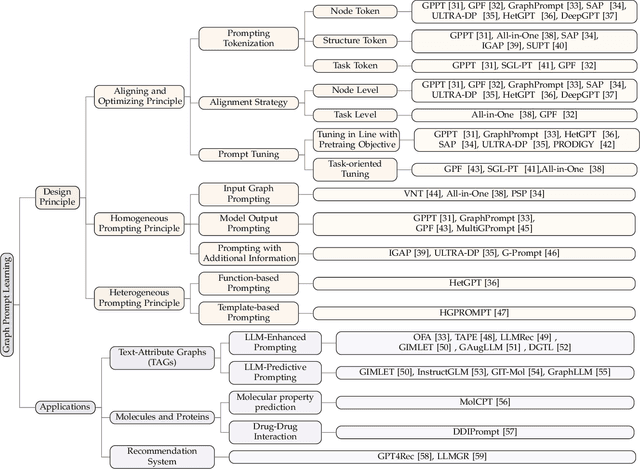

Abstract:Large-scale "pre-train and prompt learning" paradigms have demonstrated remarkable adaptability, enabling broad applications across diverse domains such as question answering, image recognition, and multimodal retrieval. This approach fully leverages the potential of large-scale pre-trained models, reducing downstream data requirements and computational costs while enhancing model applicability across various tasks. Graphs, as versatile data structures that capture relationships between entities, play pivotal roles in fields such as social network analysis, recommender systems, and biological graphs. Despite the success of pre-train and prompt learning paradigms in Natural Language Processing (NLP) and Computer Vision (CV), their application in graph domains remains nascent. In graph-structured data, not only do the node and edge features often have disparate distributions, but the topological structures also differ significantly. This diversity in graph data can lead to incompatible patterns or gaps between pre-training and fine-tuning on downstream graphs. We aim to bridge this gap by summarizing methods for alleviating these disparities. This includes exploring prompt design methodologies, comparing related techniques, assessing application scenarios and datasets, and identifying unresolved problems and challenges. This survey categorizes over 100 relevant works in this field, summarizing general design principles and the latest applications, including text-attributed graphs, molecules, proteins, and recommendation systems. Through this extensive review, we provide a foundational understanding of graph prompt learning, aiming to impact not only the graph mining community but also the broader Artificial General Intelligence (AGI) community.
Radio Frequency Signal based Human Silhouette Segmentation: A Sequential Diffusion Approach
Jul 27, 2024



Abstract:Radio frequency (RF) signals have been proved to be flexible for human silhouette segmentation (HSS) under complex environments. Existing studies are mainly based on a one-shot approach, which lacks a coherent projection ability from the RF domain. Additionally, the spatio-temporal patterns have not been fully explored for human motion dynamics in HSS. Therefore, we propose a two-stage Sequential Diffusion Model (SDM) to progressively synthesize high-quality segmentation jointly with the considerations on motion dynamics. Cross-view transformation blocks are devised to guide the diffusion model in a multi-scale manner for comprehensively characterizing human related patterns in an individual frame such as directional projection from signal planes. Moreover, spatio-temporal blocks are devised to fine-tune the frame-level model to incorporate spatio-temporal contexts and motion dynamics, enhancing the consistency of the segmentation maps. Comprehensive experiments on a public benchmark -- HIBER demonstrate the state-of-the-art performance of our method with an IoU 0.732. Our code is available at https://github.com/ph-w2000/SDM.
Deep Frequency Derivative Learning for Non-stationary Time Series Forecasting
Jun 29, 2024Abstract:While most time series are non-stationary, it is inevitable for models to face the distribution shift issue in time series forecasting. Existing solutions manipulate statistical measures (usually mean and std.) to adjust time series distribution. However, these operations can be theoretically seen as the transformation towards zero frequency component of the spectrum which cannot reveal full distribution information and would further lead to information utilization bottleneck in normalization, thus hindering forecasting performance. To address this problem, we propose to utilize the whole frequency spectrum to transform time series to make full use of data distribution from the frequency perspective. We present a deep frequency derivative learning framework, DERITS, for non-stationary time series forecasting. Specifically, DERITS is built upon a novel reversible transformation, namely Frequency Derivative Transformation (FDT) that makes signals derived in the frequency domain to acquire more stationary frequency representations. Then, we propose the Order-adaptive Fourier Convolution Network to conduct adaptive frequency filtering and learning. Furthermore, we organize DERITS as a parallel-stacked architecture for the multi-order derivation and fusion for forecasting. Finally, we conduct extensive experiments on several datasets which show the consistent superiority in both time series forecasting and shift alleviation.
 Add to Chrome
Add to Chrome Add to Firefox
Add to Firefox Add to Edge
Add to Edge